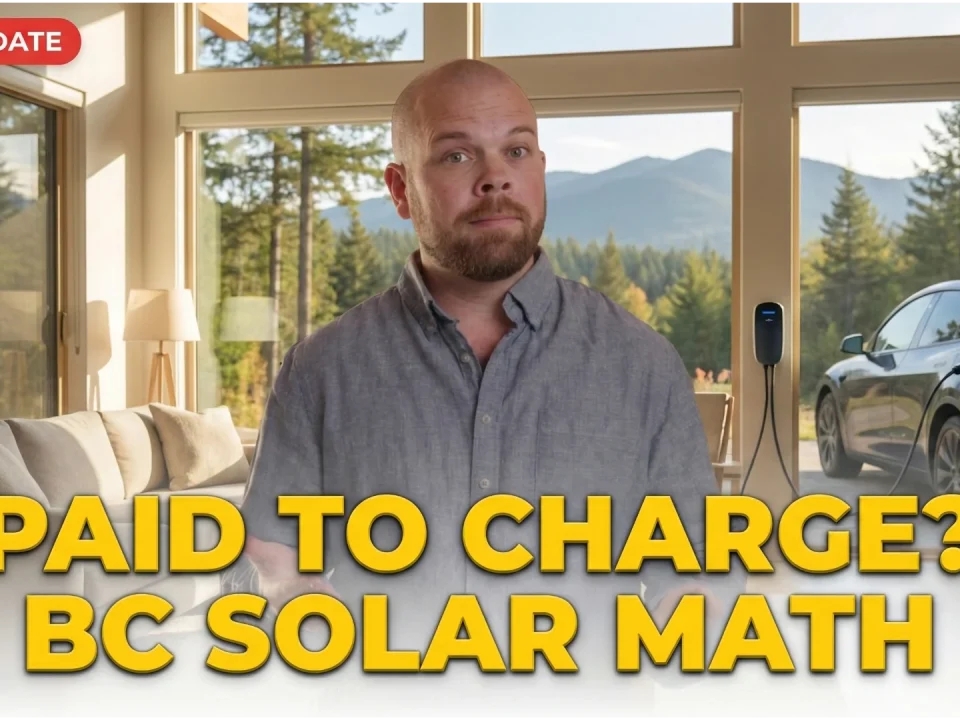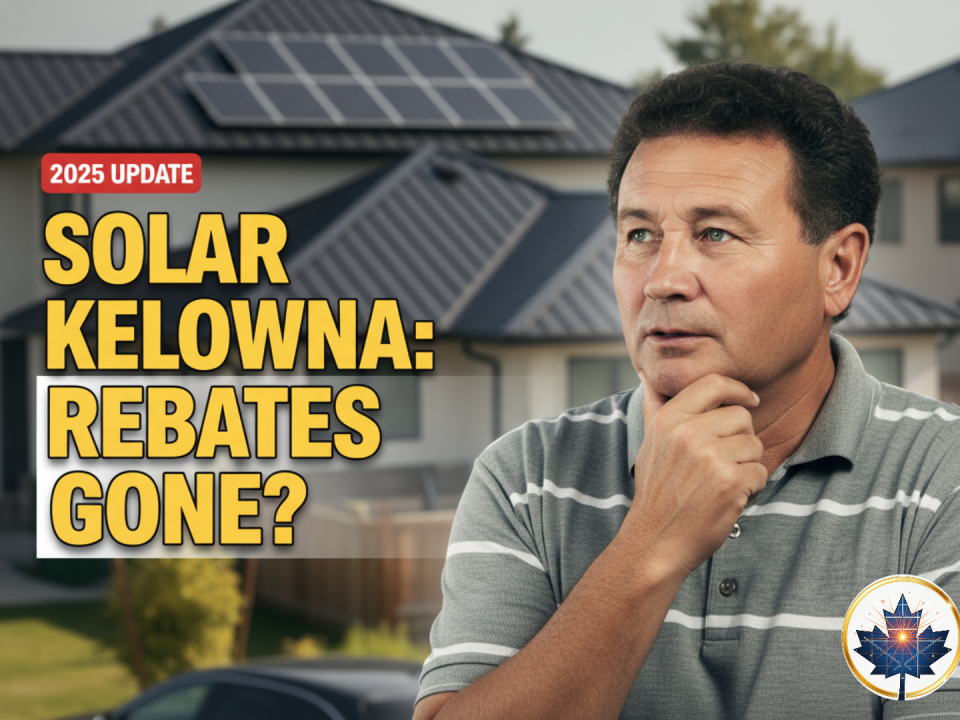
Best Solar Companies in Nova Scotia For Solar Panels
April 7, 2025
Tesla Solar Roof and Powerwall in Canada: What’s Really Going On?
April 10, 2025One question I get asked all the time is about the price of solar panels. Should you jump in now, or wait? It’s a big decision, and the price tag is obviously a huge part of it. So, let’s break down what’s been happening with solar photovoltaic (PV) module prices here in Canada and what we might see heading into 2025. We’ll look at the trends, the ‘why’ behind them, and what government help is out there to make things easier on your wallet. No fluff, just the facts to help you make a smart choice.
What’s Been Happening with Solar Panel Prices Lately (2022-2024)?
Globally, the solar scene has been on a bit of a wild ride. You might have heard about prices dropping – and they did, big time. Between the end of 2022 and the end of 2023, the worldwide spot price for solar modules actually fell by about 50%. That’s massive! The main reason was a surge in manufacturing capacity, basically more panels being made than were immediately needed, leading to intense competition. Since Canada imports a lot of its panels, this global trend definitely put downward pressure on module costs here.
But here’s where it gets interesting for us in Canada. While the global price of the panels themselves dipped and then kind of leveled off near record lows (around $0.10 per watt direct current, or Wdc, in late 2024), the total cost to install a solar system here actually went up.
Confusing, right? Let me explain. Data shows the average cost per watt for a full installation in Canada climbed from about $3.01 in 2021 to somewhere between $3.34 and $3.50 by 2024. In 2023, the average was $3.34 per watt, meaning a typical 7.5kW home system cost around $25,050 to install. So, even though the panels got cheaper globally for a while, other costs – things like labor, inverters, racking, wiring, and maybe even some lingering supply chain hiccups – pushed the final price tag up for Canadians.
Installation Costs Creeping Up: A Quick Look
Here’s a simplified table showing that upward trend in installation costs, even while module prices were globally low for part of this time:
| Year | Average cost per watt (National) reflects the current market trends in solar pv technology. | Range of Cost per Watt (by Province) |
|---|---|---|
| 2021 | $3.01 | (Not readily specified in sources) |
| 2022 | (Not readily specified in sources) | (Not readily specified in sources) |
| 2023 | $3.34 | Varies significantly (e.g., $2.42-$3.05/W in ON) |
| 2024 | $3.34 – $3.50 | ~$2.60/W (AB) to $2.42/W (ON) up to $4.00+/W (NU) |
It’s also worth remembering that costs aren’t uniform across the country. Early 2024 saw Alberta reporting lower costs, around $2.60 per watt, while places like Nunavut were significantly higher. Your local market for solar panels cost really matters.
Why the Price Swings? The Forces at Play
So what caused this mix of falling module prices globally but rising installation costs here? Several things are going on:
- Global Panel Overload: As mentioned, factories worldwide ramped up production faster than demand grew, creating a surplus of panels. This forced manufacturers to slash prices to move inventory.
- Raw Material Costs: Polysilicon is a key ingredient. Its price influences module costs. While polysilicon prices dipped in late 2024, sometimes even below production cost for some makers, the market oversupply kept overall module prices down. This can’t last forever, though.
- Tech Advancements: The industry is constantly improving, moving to more efficient cells like PERC and now TOPCon. While awesome for long-term performance and cost, these transitions can cause short-term price fluctuations as factories retool. New tech might cost a bit more initially until production scales up.
- Supply Chain Snags: Remember those pandemic-related disruptions? They likely played a part in higher overall installation costs in Canada, affecting things beyond just the panels, like transportation and availability of other components.
- Labor and ‘Soft Costs’: This is a big one for Canada. Even with cheaper panels, the costs for skilled labor, inverters, mounting systems, wiring, permits, and design haven’t necessarily dropped – in fact, they seem to have increased, offsetting module savings.
Peeking into the Crystal Ball: What Might 2025 Hold for Prices?
Predicting the future is tricky, but experts have some ideas.
Some analysts think the big price drops for modules might be over, at least for now. They suggest we could see prices stabilize or even nudge up slightly as manufacturers can’t sustain selling below cost and might cut production to balance supply.
However, don’t expect prices to suddenly skyrocket. The long-term trend for solar costs has consistently been downward. Think about it: module costs are down an incredible 99% since 1980! Continued innovation and economies of scale should keep pushing costs lower over the long haul. Some global forecasts even suggested wholesale module prices could stay around that $0.10/W mark into 2025, though retail prices for homeowners will always be higher due to markups and other costs.
Demand is also growing fast, both globally and here in Canada. The Canadian solar market is expected to grow significantly, around 9% compound annual growth rate (CAGR) from 2024 to 2030. While strong demand can eventually push prices up, the current oversupply situation seems to be the bigger factor keeping module prices low for the moment.
Solar Energy Growth In Past 10 Years In Different Countries
Factors Shaping Future Prices
Looking ahead, keep an eye on these key influencers:
- Technology: Better, more efficient cells (TOPCon, HJT) and higher wattage panels (like 700W+ modules) mean you get more power from less space, potentially lowering overall system costs.
- Government Policies: Incentives are HUGE. Federal and provincial programs directly impact affordability. Supportive policies fuel market growth, which can foster competition and potentially lower prices long-term.
- Supply Chains: Smoother global supply chains mean more stable prices. Diversification efforts could help.
- Raw Materials: The cost of silicon, silver, aluminum, etc., will always be a factor.
- Trade Rules can impact the solar module prices in different regions. As we import many panels, tariffs and trade agreements can swing prices either way.
Your Secret Weapon: Government Incentives
Okay, let’s talk about the good stuff – programs designed to make solar power more affordable right here in Canada.. These can make a massive difference to your upfront cost.
Federal Help:
- Canada Greener Homes Loan: This is a big one. Eligible homeowners can get an interest-free loan of up to $40,000 for renos, including solar panels. The grant part ended, but the 10-year, 0% loan is still a major help.
- Clean Technology Investment Tax Credit: For businesses, this offers a refundable tax credit of 30% on eligible clean tech investments, including commercial solar.
Provincial & Municipal Goodies:
These vary a LOT by where you live, so you absolutely need to check your local options. But here are some examples to give you an idea:
- BC: BC Hydro offers rebates (up to $5k for solar, $5k for battery storage).
- Alberta has competitive solar module prices that could benefit homeowners. Municipal programs exist, like Edmonton’s rebate or financing options.
- Saskatchewan’s solar installation incentives are worth exploring. Business tax incentives and Saskatoon’s loan program.
- Manitoba: Rebates via Efficiency Manitoba.
- Ontario: A Home Renovation Savings Program offers rebates, plus net metering and municipal loan options like Toronto’s HELP.
- Nova Scotia: Rebates through the SolarHomes Program can significantly reduce the cost of solar panels..
- PEI offers unique opportunities for solar installation and incentives. Generous rebates and loan programs.
Net Metering: Pretty much available across Canada, this lets you earn credits on your electricity bill for extra power your panels send to the grid. It’s a key part of making solar pay off.
Quick Look at Some 2025 Residential Incentives
| Province/Territory | Incentive Name | Type of solar power system can influence overall costs and efficiency. | Max Amount/Value | Key Notes |
|---|---|---|---|---|
| Federal | Canada Greener Homes Loan | Interest-free loan | Up to $40,000 | Homeowner, energy audit needed |
| BC | BC Hydro Power Smart | Rebate | Up to $5k (solar), $5k (battery) | BC Hydro customer, own home, grid-connected |
| AB (Edmonton) | Change Homes For Climate | Rebate | $0.50/watt, up to $4k | Multi-unit residential in Edmonton |
| SK (Saskatoon) | City of Saskatoon HELP | Low-interest loan | $1k – $60k | Saskatoon homeowners |
| MB | Efficiency MB Solar Rebate | Rebate | $0.50/watt, up to $5k | MB Hydro connection, primary residence |
| ON | Home Reno Savings Program | Rebate | Up to 30% of cost, max $10k | Ontario homeowners, eligible improvements |
| NS | SolarHomes Program | Rebate | $0.30/watt, up to $3k | Homeowner, site visit participation |
| PEI | Solar Electric Rebate | Rebate | $1k/kW, up to $10k or 40% of costs | Residential, commercial, agricultural eligible |
(Source: Adapted from provided document. Always check official sources for current details!)
Agriculture and Solar Mixing in Nova Scotia: Exploring Agrivoltaics
Tip for Navigating Incentives: These programs change! Seriously, check the official federal, provincial, and your municipal websites for the latest info, eligibility rules, and deadlines before you commit to anything. What’s available today might not be tomorrow.
The Million-Dollar Question: Buy Solar Now or Wait?
Alright, the moment of truth. Based on all this, should you pull the trigger on solar panels now, or hold off?
Why Buying Now Makes Sense for Many:
- Grab Those Incentives: The current batch of incentives, especially that federal interest-free loan, is pretty compelling. There’s no guarantee these programs will stay the same forever. I remember helping a family just last year time their installation perfectly to maximize a provincial rebate that was changing – it saved them thousands. Acting now locks in today’s deals.
- Start Saving Immediately: The sooner your panels are up, the sooner you start cutting your electricity bills. Those savings start adding up right away.
- Hedge Against Rising Energy Costs: Utility rates aren’t likely to go down. Generating your own power gives you stability and protects you from future price hikes.
- Instant Green Cred: Going solar immediately reduces your carbon footprint. Good for the planet, good for the soul.
- Boost Home Value: Solar panels can make your home more attractive to buyers if you decide to sell down the road, particularly if you have bifacial or monocrystalline options..
Why You Might Consider Waiting:
- Potential for Cheaper Panels (Long Term): While prices might level off short-term, the historical trend is downward, especially when considering the average price of solar panels.. Future tech could bring costs down further eventually.
- Hope for Better Incentives?: It’s possible governments could roll out even more generous programs later, though banking on this is speculative.
- Next-Gen Tech: Waiting might give you access to slightly more efficient panels hitting the market later.
Making Your Call
Honestly, there’s no single right answer for everyone. It boils down to your situation:
- Your Energy Bills: Got high electricity costs? You’ll feel the savings faster.
- Your Budget: Can you manage the upfront cost, even with loans/incentives?
- Your location greatly affects the solar installation options available to you. What specific incentives are available to you right now? This is critical.
- How Long You’ll Stay Put: The longer you’re in your home, the more time you have for the system to pay for itself and generate savings.
- Your Comfort Level: How do you feel about potential price changes versus locking in current deals?
Tip for Decision Making: Don’t go it alone! Get at least 2-3 detailed quotes from reputable, local solar installers. They can assess your specific property, explain the costs breakdown (not just modules!), and guide you through the incentives you qualify for. Compare carefully!
So, What’s the Bottom Line for 2025?
Looking at the whole picture – the global module prices stabilizing at low levels, the rising installation costs here in Canada due to other factors, the potential for near-term price stability, and the really attractive government incentives currently on the table – the needle leans towards acting sooner rather than later for many Canadians.
Why consider solar power? The long-term savings can be substantial. Because those incentives, especially the federal interest-free loan, significantly soften the upfront investment. Waiting for potentially lower module prices down the road means risking these valuable support programs changing or disappearing, while also delaying your energy savings and paying current, potentially rising, electricity rates.
But – and this is important – do your homework. This isn’t a blind recommendation. You absolutely must investigate the specific incentives in your province and municipality for solar installation.. Talk to qualified installers, get those quotes, and understand the total cost and projected savings for your home.
Making the switch to solar is a big step, but it can be a fantastic investment in your home and our planet. At SolarEnergies.ca, we’re here to provide that honest, helpful guidance to connect you with the right solution.
Got questions? Feel free to reach out! Let’s figure out if 2025 is your year to go solar.








